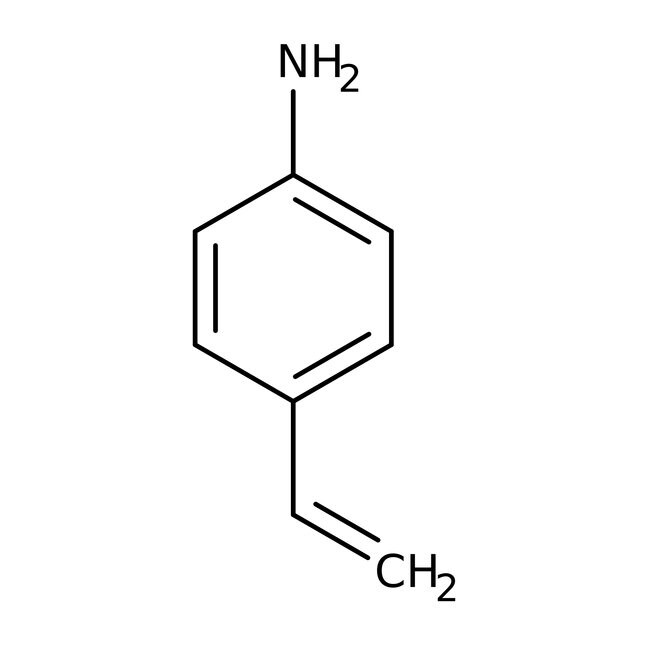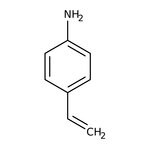Search Thermo Fisher Scientific
Thermo Scientific Chemicals
4-Aminostyrene, 97%, stab., Thermo Scientific Chemicals
Catalog number: L11845.06
5 g, Each



Thermo Scientific Chemicals
4-Aminostyrene, 97%, stab., Thermo Scientific Chemicals
Catalog number: L11845.06
5 g, Each
Quantity
Catalog number: L11845.06
also known as L11845-06
Price (USD)
Special offer:
166.65 196.00 Save 29.35 (14%)
Ends: 15-Oct-2024
Each
Quantity
-
Chemical Identifiers
CAS
1520-21-4
IUPAC Name
4-ethenylaniline
Molecular Formula
C8H9N
InChI Key
LBSXSAXOLABXMF-UHFFFAOYSA-N
SMILES
NC1=CC=C(C=C)C=C1
Specifications
Appearance (Color)
White (or colorless) to yellow to yellow-orange or orange-red
Identification (FTIR)
Conforms
Solution Test
(10% w/v in diethyl ether) : Clear
Form
Low-melting fused solid (clear liquid as melt)
Solution Test
(10% w/v in methanol) : Clear
Description
4-Aminostyrene undergoes graft copolymerization with poly(tetrafluoroethylene) (PTFE)1 and Si surface,2 followed by oxidative copolymerization with aniline. Thus, it renders PTFE and Si surface conductive.1 4-VAn is coupled with hydrogen terminated Si surfaces for electroless metal and synthetic metal deposition.3 Palladium(II) schiff base complexes derived from Allylamine and vinylaniline has been reported.4 It also acts as a second surfactant for coating nanomagnetic particles.5 It is used in functionalization of single-walled carbon nanotube through solvent free functionalization.
This Thermo Scientific Chemicals brand product was originally part of the Alfa Aesar product portfolio. Some documentation and label information may refer to the legacy brand. The original Alfa Aesar product / item code or SKU reference has not changed as a part of the brand transition to Thermo Scientific Chemicals.
Applications
4-Aminostyrene undergoes graft copolymerization with poly(tetrafluoroethylene) (PTFE)1 and Si surface,2 followed by oxidative copolymerization with aniline. Thus, it renders PTFE and Si surface conductive.1 4-VAn is coupled with hydrogen terminated Si surfaces for electroless metal and synthetic metal deposition.3 Palladium(II) schiff base complexes derived from Allylamine and vinylaniline has been reported.4 It also acts as a second surfactant for coating nanomagnetic particles.5 It is used in functionalization of single-walled carbon nanotube through solvent free functionalization.
Solubility
Soluble in benzene, acetone and methanol.
Notes
Keep container tightly sealed. Store in cool, dry conditions in well sealed containers. Incompatible with oxidizing agents.
4-Aminostyrene undergoes graft copolymerization with poly(tetrafluoroethylene) (PTFE)1 and Si surface,2 followed by oxidative copolymerization with aniline. Thus, it renders PTFE and Si surface conductive.1 4-VAn is coupled with hydrogen terminated Si surfaces for electroless metal and synthetic metal deposition.3 Palladium(II) schiff base complexes derived from Allylamine and vinylaniline has been reported.4 It also acts as a second surfactant for coating nanomagnetic particles.5 It is used in functionalization of single-walled carbon nanotube through solvent free functionalization.
Solubility
Soluble in benzene, acetone and methanol.
Notes
Keep container tightly sealed. Store in cool, dry conditions in well sealed containers. Incompatible with oxidizing agents.
RUO – Research Use Only
Figures
Documents & Downloads
Certificates
Search by lot number or partial lot number
Frequently asked questions (FAQs)
Citations & References
Search citations by name, author, journal title or abstract text